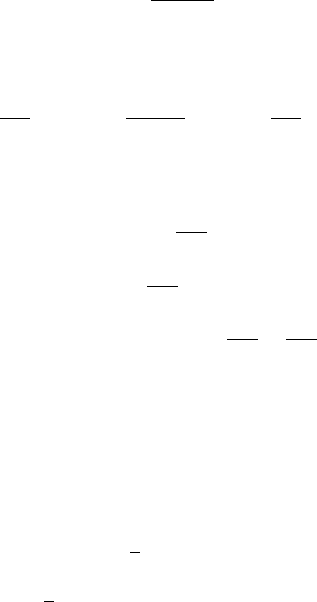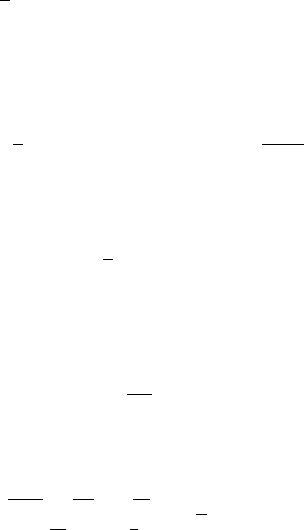Taylor M.E. Partial Differential Equations III: Nonlinear Equations
Подождите немного. Документ загружается.

498 16. Nonlinear Hyperbolic Equations
4. Strengthen Proposition 7.1 as follows. Under the hypotheses of that proposition:
Claim. Given u
0
2 , there is a neighborhood O of u
0
such that if u
`
; u
r
2 O,then
there is a weak solution to (7.1) with initial data u.0; x/ D u
`
for x<0;u
r
for
x>0.
What is the difference? Similarly strengthen Proposition 7.3.
5. Consider shock wave solutions to the system produced in Exercise 1 of 5, namely,
spherically symmetric shocks in compressible fluids.
6. Show that a solution to the system (7.1)isgivenby
(7.116) u.t; x/ D v
'.t; x/
;
where ' is real-valued, satisfying the scalar conservation law
(7.117) '
t
C
j
v.'/
'
x
D 0;
for some j ,andv
0
.s/ is parallel to r
j
v.s/
, with
j
;r
j
as in (7.3).
Such a solution is called a simple wave. Rarefaction waves are a special case, called
centered simple waves.
Considering (7.117), study the breakdown of simple waves.
8. Entropy-flux pairs and Riemann invariants
As in 7, we work with an L L system of conservation laws in one space
variable:
(8.1) u
t
C F.u/
x
D 0;
where u takes values in R
L
and F W ! R
L
is smooth. Thus smooth
solutions also satisfy
(8.2) u
t
C A.u/u
x
D 0; A.u/ D D
u
F.u/:
As noted in 7,ifu.t; x/ vanishes sufficiently rapidly as x !˙1,then
(8.3)
Z
u.t; x/ dx 2 R
L
is independent of t; so each component of (8.3) is a conserved quantity.
An entropy-flux pair is a pair of functions
(8.4) ; q W ! R
with the property that the equation (8.1) implies

8. Entropy-flux pairs and Riemann invariants 499
(8.5) .u/
t
C q.u/
x
D 0
as long as u is smooth. If there is such a pair, again given appropriate behavior as
x !˙1,wehave
(8.6)
d
dt
Z
u.t; x/
dx D 0;
so
(8.7)
Z
u.t; x/
dx D I
.u/
is independent of t, hence is another conserved quantity, provided u.t; x/ is
smooth. As we’ll see below, the situation is different for nonsmooth, weak so-
lutions to (8.1).
To produce a more operational characterization of entropy-flux pairs, apply the
chain rule to the left side of (8.5), to get u
t
r.u/ C u
x
rq.u/, and substitute
u
t
DA.u/u
x
from (8.2), to get
(8.8) .u/
t
C q.u/
x
D u
x
A.u/
t
r.u/ Crq.u/
:
Thus the condition for .; q/ to be an entropy-flux pair for (8.1)isthat
(8.9) A.u/
t
r.u/ Drq.u/:
Note that (8.9) consists of L equations in two unknowns. Thus it is overdeter-
mined if L 3.ForL 3, some special structure is usually required to produce
nontrivial entropy-flux pairs. For example, if A.u/ is symmetric,so@F
j
=@u
k
D
@F
k
=@u
j
,andif R
L
is simply connected, we can set F
`
.u/ D @g=@u
`
.In
such a case,
(8.10) .u/ D
1
2
X
u
2
j
;q.u/ D
X
u
j
F
j
.u/ g.u/;
is seen to define an entropy-flux pair. Note that in this case is a strictly convex
function of u.
If L D 2,then(8.9) is a system of two equations in two unknowns. We can
convert it to a single equation for as follows (assuming is simply connected).
The condition that A
kj
.u/@=@u
k
be a gradient field is that
(8.11)
@
@u
`
A
kj
.u/
@
@u
k
D
@
@u
j
A
k`
.u/
@
@u
k
;
for all j; `. We use the summation convention and hence sum over k in (8.11). We
need verify (8.11) only for j<`, hence for j D 1; ` D 2,ifL D 2. Carrying
out the differentiation, we can write (8.11)as

500 16. Nonlinear Hyperbolic Equations
(8.12)
ı
m
`
A
kj
.u/ ı
m
j
A
k`
.u/
@
2
@u
m
@u
k
D 0; 8 j<`:
In case L D 2, this becomes the single equation
(8.13) B
11
.u/
@
2
@u
2
1
C 2B
12
.u/
@
2
@u
2
@u
1
C B
22
.u/
@
2
@u
2
2
D 0;
with
(8.14)
B
11
.u/ DA
12
.u/ D
@F
1
@u
2
;
B
22
.u/ D A
21
.u/ D
@F
2
@u
1
;
2B
12
.u/ D A
11
.u/ A
22
.u/ D
@F
1
@u
1
@F
2
@u
2
:
Lemma 8.1. If (8.2)isa2 2 system, then (8.13) is a linear hyperbolic equation
for if and only if (8.2) is strictly hyperbolic.
Proof. The equation (8.13) is hyperbolic if and only if the matrix B.u/ D
B
jk
.u/
has negative determinant. We have
det B.u/ DA
12
A
21
1
4
.A
11
A
22
/
2
D
1
4
.A
2
11
2A
11
A
22
C A
2
22
C 4A
12
A
21
/:
Meanwhile,
det
A.u/
D
2
.A
11
C A
22
/ C A
11
A
22
A
12
A
21
;
so A.u/ has two real and distinct eigenvalues if and only if
.A
11
C A
22
/
2
4.A
11
A
22
A
12
A
21
/>0:
This last quantity is seen to be equal to 4 det B.u/, so the lemma is proved.
We will be particularly interested in producing entropy-flux pairs .; q/ such
that is convex. The reason for doing so is explained by the following result,
which extends (6.21)–(6.24).
Proposition 8.2. Consider solutions u
"
of
(8.15) @
t
u
"
C A.u
"
/@
x
u
"
D "@
2
x
u
"
;">0:

8. Entropy-flux pairs and Riemann invariants 501
Suppose that, as " & 0; u
"
converges boundedly a.e. to u, a weak solution of
(8.16) @
t
u C @
x
F.u/ D 0:
If .; q/ is an entropy-flux pair and is convex, then
(8.17) .u/
t
C q.u/
x
0;
in the sense that this is a nonpositive measure.
Here, if F;,andq aredefinedonanopenset R
L
, we assume u
"
.t; x/ 2
K .
Proof. Take the dot product of (8.15) with r.u
"
/ to get
(8.18) @
t
.u
"
/ C @
x
q.u
"
/ D "r.u
"
/ @
2
x
u
"
:
Use the identity
(8.19) .v/
xx
Dr.v/ v
xx
C
X
j;k
jk
.v/.@
x
v
j
/.@
x
v
k
/;
jk
.v/ D
@
2
@v
k
@v
j
;
to get
(8.20)
.u
"
/
t
C q.u
"
/
x
D ".u
"
/
xx
"
X
jk
.u
"
/.@
x
u
j"
/.@
x
u
k"
/
".u
"
/
xx
;
by convexity of . Now passing to the limit " ! 0 gives
(8.21) .u
"
/ ! .u/; q.u
"
/ ! q.u/;
boundedly and a.e., hence weak
in L
1
, while the right side of (8.20) tends to 0
in the distributional topology. This yields (8.17).
The inequality (8.17) is called an entropy condition.
Suppose u is a weak solution to (8.1) which is smooth on a region O R
2
except for a simple jump across a curve O.If.; q/ is an entropy-flux pair,
then .u/
t
C q.u/
x
D 0 on O n . Suppose (8.17) holds for u. Then the negative
measure .u/
t
C q.u/
x
D is supported on ; in fact, for continuous ' with
compact support in O,
(8.22)
Z
'dD
Z
sŒ Œq
'd;

502 16. Nonlinear Hyperbolic Equations
where Œ and Œq are the jumps of and q across , in the direction of increasing t;
s D dx=dt on is the shock speed; and d is the arclength along . Consequently,
such an entropy-satisfying weak solution of (8.1) has the property
(8.23) sŒ Œq 0 on :
We remarked in 7 that if u
`
and u
r
are close and the Riemann problem (7.17)
has a solution consisting of a j -shock, satisfying the Lax shock condition (7.52),
then u
`
and u
r
are connected by a viscous profile; we sketched a proof for 2 2
systems. It follows from Proposition 8.2 that such solutions satisfy the entropy
condition (8.17), for all convex entropies.
We give some explicit examples of entropy-flux pairs. First consider the system
(7.14), namely,
(8.24)
v
t
w
x
D 0;
w
t
K.v/
x
D 0;
for which
˙
and r
˙
are given by (7.16). In this case, one can use
(8.25) .v; w/ D
1
2
w
2
C
Z
v
v
0
K.s/ ds;q.v;w/DwK.v/:
Note that is strongly convex as long as K
0
.v/ > 0.
For the equation (7.5) of isentropic compressible fluid flow, we can set
(8.26) .v; / D
1
2
v
2
C X./; X
0
./ D
Z
0
p
0
.s/
s
ds;
which is the total energy, with flux
(8.27) q.v;/ D
1
2
v
2
C X
0
./
v:
In the .; m/-coordinates used to express the PDE in conservation form (7.8), we
have
(8.28) .; m/ D
m
2
2
C X./:
In this case
(8.29) D
2
D
p
0
./
C
m
2
3
m
2
m
2
1
!
D
1
p
0
./ C v
2
v
v1
;
so .; m/ is strongly convex as long as p
0
./ > 0.

8. Entropy-flux pairs and Riemann invariants 503
We aim to present a construction of P. Lax of a large family of entropy-flux
pairs, for 2 2 systems. In order to do this, and also for further analysis in 9,it
is useful to introduce the concept of a Riemann invariant. If A.u/ D D
u
F.u/ has
eigenvalues and eigenvectors
j
.u/; r
j
.u/,asin(7.3), we say a smooth function
W ! R is a k-Riemann invariant provided r
k
r D 0.
In the case of a system of the form (7.14), where r
˙
D .1;
˙
/
t
;
˙
D
˙
.v/, we see that Riemann invariants are constant on integral curves of @=@v
˙
.v/ @=@w, that is, curves satisfying dv=dw D1=
˙
.v/, so we can take
(8.30)
˙
.v; w/ D w C
Z
v
v
0
˙
.s/ ds D w ˙
Z
v
v
0
p
K
0
.s/ ds:
Also, any functions of these are Riemann invariants.
In the case of the system (7.8) for compressible fluids (in .; m/ coordinates),
where we have r
˙
D .1;
˙
/
t
;
˙
D m= ˙
p
p
0
./, the Riemann invari-
ants are constant on integral curves of @=@ C
˙
@=@m (i.e., curves satisfying
dm=d D m= ˙
p
p
0
./). If we switch to .; v/-coordinates, with v D m=,
then dm=d D dv=dCv, so these level curves satisfy dv=dD˙
p
p
0
./.
Hencewecantake
(8.31)
˙
.; v/ D v
Z
0
p
p
0
.s/
s
ds D v
2
p
A
1
.1/=2
;
the latter identity holding when p./ D A
, with >1,andwetake
0
D 0.
The following is a useful characterization of Riemann invariants.
Proposition 8.3. Suppose that (8.1) is a strictly hyperbolic 2 2 system and that
has a coordinate system .
1
;
2
/, such that
k
is a k-Riemann invariant. Then,
for k D 1; 2,
(8.32) A.u/
t
r
k
.u/ D
j
.u/r
k
.u/; j ¤ k:
Conversely, for j D 1; 2,
(8.33) A.u/
t
r.u/ D
j
.u/r.u/ H) is a k-Riemann invariant, k ¤ j:
Proof. Since fr
1
.u/; r
2
.u/g is a basis of R
2
for each u 2 , we see that
(8.34) r
k
.u/ .u/ D 0 H) .u/ D ˛.u/r
k
.u/;
for some scalar ˛.u/. Meanwhile,
(8.35) A.u/
t
.u/ D
j
.u/.u/ ” r
k
A.u/
t
D
j
r
k
:

504 16. Nonlinear Hyperbolic Equations
Since also r
k
A.u/
t
D A.u/r
k
D
k
r
k
and
j
¤
k
, we see that
(8.36)
A.u/
t
.u/ D
j
.u/ H) r
k
.u/ .u/ D 0
H) .u/ D ˛.u/r
k
.u/;
the last implication by (8.34). However, since A.u/
t
does have a nonzero
j
-
eigenspace, this yields (8.32). It also establishes the converse, (8.33).
Proposition 8.3 has the following consequence:
Proposition 8.4. Suppose that (8.1) is a strictly hyperbolic 2 2 system and that
has a coordinate system
k
;kD 1; 2, consisting of k-Riemann invariants. If u
is a Lipschitz solution of (8.1), then
(8.37)
@
t
1
.u/ C
2
.u/@
x
1
.u/ D 0;
@
t
2
.u/ C
1
.u/@
x
2
.u/ D 0:
Proof. For j ¤ k,wehave
(8.38)
@
t
j
.u/ C
k
.u/@
x
j
.u/ D @
t
u r
j
.u/ C
k
.u/@
x
u r
j
.u/
D @
t
u r
j
.u/ C @
x
u A.u/
t
r
j
.u/
D
@
t
u C A.u/@
x
u
r
j
.u/;
the second identity by (8.32). This proves (8.37).
Following [L4], we now present a geometrical-optics-type construction of so-
lutions to (8.9), for certain 2 2 systems, which yields convex entropy functions
in favorable circumstances. We look for solutions of the form
(8.39)
D e
k'
0
C k
1
1
CCk
N
N
Ce
N
;
q D e
k'
q
0
C k
1
q
1
CCk
N
q
N
Ceq
N
;
where ' D '.u/;
j
D
j
.u/; q
j
D q
j
.u/; k is a parameter that will be taken
large, and we will havee
N
;eq
N
D O.k
N
/. In fact, plugging this ansatz into (8.9)
and equating like powers of k, we obtain
(8.40) q
0
r' D
0
A.u/
t
r';
and, for 0 j N 1,
(8.41) nq
j C1
r' Crq
j
D
j C1
A.u/
t
r' C A.u/
t
r
j
:
If
0
¤ 0,(8.40)says
(8.42) A.u/
t
r' D
q
0
0
r';

8. Entropy-flux pairs and Riemann invariants 505
so q
0
=
0
is an eigenvalue of A.u/
t
and r' an associated eigenvector. By
Proposition 8.3, the equation (8.40) holds provided we take
(8.43) q
0
D
`
0
;'D
k
;k¤ `;
where
`
is one of the two eigenvalues of A.u/ and
k
is a k-Riemann invariant.
We have solved the eikonal equation for '. For definiteness, let us take k D 1;
` D 2.
Rather than tackle (8.41) directly, let us note that (8.9) is equivalent to
(8.44) R
q D
R
; R
D r
r;D 1; 2:
Thus we can rewrite (8.40)and(8.41)as
(8.45) q
0
R
' D
0
R
'; D 1; 2;
and, for 0 j N 1,
(8.46) q
j C1
R
' C R
q
j
D
j C1
R
' C
R
j
;D 1; 2:
Clearly, (8.43) yields ';q
0
;
0
satisfying (8.45). We have
(8.47) R
1
' D 0; R
2
' D R
2
1
:
Thus (8.46) takes the form
(8.48) R
1
q
j
D
1
R
1
j
;.q
j C1
2
j C1
/.R
2
k
/ D
2
R
2
j
R
2
q
j
:
For j D 0,usingq
0
D
2
0
, we obtain the transport equation
(8.49) R
1
0
C
R
1
2
2
1
0
D 0;
which is an ODE along each integral curve of R
1
. This specifies
0
, given initial
data on a curve transverse to R
1
,andthenq
0
is specified by (8.43). We can arrange
that
0
>0. Note that this specification of
0
;q
0
is independent of the choice of
1-Riemann invariant ' D
1
.
Similarly the higher transport equations (i.e., (8.48)forj 1), give
j
and q
j
,
for j 1. Compare the geometrical optics construction in 6 of Chap. 6. Once
the transport equations have been solved to high order, one is left with a nonho-
mogeneous, linear hyperbolic system to solve, to obtain exact solutions .; q/ to
(8.9).
It is also useful to write the transport equation (8.46) using the Riemann invari-
ants .
1
;
2
/ as coordinates on , if that can be done. We obtain for D .
1
;
2
/
and q D q.
1
;
2
/ the system

506 16. Nonlinear Hyperbolic Equations
(8.50)
@q
@
1
D
2
@
@
1
;
@q
@
2
D
1
@
@
2
;
equivalent to (8.9)andto(8.44), and, if ' D
1
,then(8.46) becomes
(8.51)
@q
j
@
2
D
1
@
j
@
2
;q
j C1
2
j C1
D
2
@
j
@
1
@q
j
@
1
:
The equation (8.49) takes the form
(8.52)
@
0
@
2
C
1
2
1
@
2
@
2
0
D 0:
As stated in (8.43), we have q
0
D
2
0
. We also record one implication of (8.51)
for
1
;q
1
:
(8.53) q
1
2
1
D
@
2
@
1
0
:
In particular, if
0
>0,thenq
1
2
1
has the opposite sign to @
2
=@
1
(if this
is nonvanishing, which is the case if (8.1) is genuinely nonlinear).
Since it is of interest to have convex entropies , we make note of the following
result, whose proof involves a straightforward calculation:
Proposition 8.5. If .k/ is given by (8.39), with
0
>0on , then, for k suf-
ficiently large and positive, .k/ is strongly convex on any given
0
,
provided r' ¤ 0 on and, at any point u
0
2 ,ifV D a
1
@=@u
1
C a
2
@=@u
2
,
is a unit vector orthogonal to r'.u
0
/,then
(8.54) V
2
'.u
0
/>0:
If ' satisfies the hypotheses of Proposition 8.5,wesay' is (strongly) quasi-
convex. Clearly, (8.54) implies that a tangent line to f' D cg at u
0
lies in f'>cg
on a punctured neighborhood of u
0
. Equivalently, ' is quasi-convex on R
2
if
and only if the curvature vector of each level curve f' D cg at any point u
0
2 is
antiparallel to the vector r'.u
0
/. Note that if is convex and ' is quasi-convex
on , then each region f' cg is convex.
Thus a favorable situation for exploiting the construction (8.39) to obtain a
strongly convex entropy is one where has a coordinate system .
1
;
2
/ consist-
ing of quasi-convex Riemann invariants. Note that if this is the case, we can form
j
D e
j
, for some large constant , and obtain a coordinate system consisting
of strongly convex Riemann invariants.
Consider the Riemann invariants
˙
of (8.30), for the system (7.14), containing
models of elasticity. We see that
C
and
are quasi-convex, where K
00
.v/ > 0,
and that
C
and
are quasi-convex, where K
00
.v/ < 0, granted that K
0
.v/ is

Exercises 507
nowhere vanishing. As for the Riemann invariants (8.31) for the system (7.7)of
compressible fluid flow, with variables .v; /,given1<<3we have
C
and
quasi-convex on f.v; / W >0g.
We end this section with the remark that the proof of Proposition 8.4 provides
just a taste of the use of geometrical optics in nonlinear PDE, extending such
developments of geometrical optics for linear PDE as discussed in Chap. 6. For
further results on nonlinear geometrical optics, one can consult [JMR]and[Kic],
and references given therein. In particular, [Kic] describes how constructions of
nonlinear geometrical optics lead to such “soliton equations” as the Korteweg–
deVries equation, the sine-Gordon equation, and the “nonlinear Schr¨odinger
equation.” Studies of propagation of weak singularities of solutions to nonlin-
ear equations, initiated in [Bon]and[RR], have also been pursued in a number of
papers. Expositions of some of these results are given in [Bea, H,Tay].
Exercises
1. Assume .; q/ is an entropy-flux pair for (8.1), and fix u
0
2 . Show that
(8.55)
e.u/ D .u/ .u
0
/ .u u
0
/ r.u
0
/;
eq.u/ D q.u/ q.u
0
/
F.u/ F.u
0
/
r.u
0
/
is also an entropy-flux pair. Note that if is strictly convex, then
e.u/ 0,andit
vanishes if and only if u D u
0
.
Exercises 2–4 involve an L L system of conservation laws in n space variables:
(8.56) u
t
C
n
X
j D1
@
j
F
j
.u/ D 0;
where F
j
W ! R
L
;open in R
L
. An entropy-flux pair is a pair of functions
W ! R;qW ! R
n
;
satisfying
(8.57) A
j
.u/
t
r.u/ Drq
j
.u/; 1 j n;
where A
j
.u/ D D
u
F
j
.u/; q.u/ D
q
1
.u/;:::;q
n
.u/
. This material is from [FL2].
2. Show that if (8.57) holds, then any smooth solution to (8.56) also satisfies
.u/
t
C
X
j
@
j
q
j
.u/ D 0:
3. Show that if each A
j
.u/ is a symmetric L L matrix, then an entropy-flux pair is
given by
.u/ D
1
2
juj
2
;q
j
.u/ D
X
`
u
`
F
j`
.u/ g
j
.u/;
where F
j
.u/ D
F
j1
.u/;:::;F
jL
.u/
;F
j`
.u/ D @g
j
=@u
`
.
